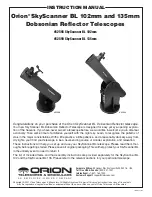
EN
Interesting information for starting
By buying a telescope you made the decision to pursue a very interesting and exciting hobby and we
congratulate you. We would like to give you a couple of tips upfront.
Astronomy isn’t a cinema movie
Astronomy isn’t a cinema movie that you watch for a couple of hours without doing anything. This great
hobby needs a lot of self-initiative and a high self-motivation. Take your time for this beautiful hobby,
because, like with many other things, you have to practice the handling of a telescope, how to properly view
things with it and the orientation. The pictures that you’ll see are also not the ones that you’ve seen as
colored pictures from NASA or that you know from the media. So don’t be disappointed when you’ll get to
see how an object really looks like through your own telescope.
Don’t expect too much at once and approach the topic slowly. You’ll only see as much as your experience
and your ability allow you to see, even with the best and most expensive telescope. The journey is the
destination and the fascinating thing about this hobby is the independent discovery of the objects and the
analysis of time and space.
Learning from others
The exchange with other astronomers is an important factor and nowadays this can be easily done through
the many Internet forums. By talking with like-minded people you can get tips and solve many problems and
answer many questions yourself. Maybe you’re also looking for an astronomy club near you?
There are countless objects in the sky that can be seen with a telescope. A map of the stars is essential, so
that you’re able to orientate and find specific objects. You can find and purchase one that is robust and made
of plastic on the Internet.
It’s essential to buy an astronomy book that’s suitable for you and we recommend that you don’t eschew this
purchase. Our experiences have shown that hobby astronomers get better observation results and also
derive a lot of joy from this hobby by using a book.
Children should watch together with someone else, who is already experienced with a telescope, if possible.
Not every location is suitable for observing
It’s best to look for a spot that is as dark as possible. You’re lucky if you live outside of the city. The ones
living in the city should drive outside of it to get better observation conditions. Because it’s almost impossible
to find a dark observation location in the city, due to the many light sources.
Consider that the temperature of the telescope has to adapt to the outside temperature to get decent
observation results.
The underground is also determining the observation quality
Avoid pulling out the tripod legs completely and erecting the tripod when it’s very windy, so that you have a
proper footing. The flatter the instrument is standing the more stable it is.
Make sure that the tripod is standing on a firm ground. Balconies, wooden floors or other undergrounds can
make observations more difficult, due to their high self-oscillation.
Free sight for your telescope
Don’t observe through a window or through an open balcony door, because the temperature differences
between inside and outside and/or the thick window glass are making it impossible to get a sharp picture.
How does a telescope actually work?
A telescope collects the weak light of the stars better than a human eye is able to. Thus you can see more in
the sky with it.
Depending on the kind of objective you distinguish between refracting telescope and reflecting telescope.
Both have the same job; to capture the light of a distant object and accumulate it at the focal point, where the
ocular will then magnify the image. All telescopes create an image that is turned by a 180 degree angle; so
it’s upside down and mirror-inverted
Telescope designs
The refracting telescope:
You look into a refracting telescope at the rear end. They are also called refractors, because they break the
light (Latin “fractere”=breaking). The light falls from the frontal lens onto a second lens and from there
through an “ocular” into the eye.




















